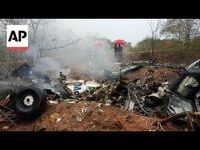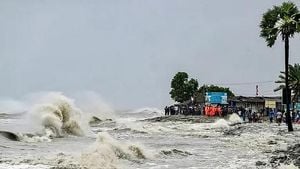In the early hours of October 28, 2025, tragedy struck the skies over Kenya’s picturesque coast as a small passenger plane, a Cessna 208B Grand Caravan operated by Mombasa Air Safari, crashed in the hilly, forested area of Kwale County. All eleven people on board—eight Hungarian tourists, two Germans, and their Kenyan pilot—lost their lives in the accident, which has since sent shockwaves through the international travel and tourism community.
The doomed flight had departed from the Diani airstrip, a popular launching point for safari-bound travelers, and was en route to the renowned Maasai Mara National Reserve, specifically the Kichwa Tembo Airstrip. According to the Kenya Civil Aviation Authority (KCAA), the crash occurred at approximately 5:30 a.m. local time, just minutes after takeoff, and about 40 kilometers from Diani. The aircraft’s registration number was 5Y-CCA, and it had enjoyed a solid safety record, having operated in Kenyan skies for more than a decade.
Mombasa Air Safari, which specializes in ferrying tourists between Kenya’s coastal resorts and inland safari destinations, confirmed the devastating loss in a statement: “We are profoundly saddened to report that there are no survivors. Our hearts and prayers are with all those affected by this tragic event.” The airline’s chairman, John Cleave, expressed the company’s deep regret and pledged full cooperation with authorities investigating the cause of the crash. The company also activated its emergency response team and established a Family Assistance Team to provide counseling, logistical coordination, and support to the victims’ relatives.
Among the Hungarian victims was Gyula Süllős, a decades-long supporter and president of the Vasas SC boxing program in Budapest. The Vasas SC sports club, in a statement, described Süllős as “a decades-long supporter” and a central figure in its boxing community. According to Hungary’s Foreign Minister Péter Szijjártó, the Hungarian victims included two families, with two children among the deceased. The loss has resonated deeply both in Hungary and across Europe, as communities mourn the sudden and tragic deaths of their loved ones.
Eyewitnesses in the Tsimba Golini area, where the wreckage was found, reported hearing a loud explosion before the aircraft burst into flames. The impact completely destroyed the plane, scattering debris across the rain-soaked, dense forest. Rescue workers and investigators from the KCAA rushed to the scene, but there were no survivors. The crash site was quickly cordoned off, and local authorities, including police and emergency services, responded swiftly despite the challenging conditions. Heavy rain and unpaved roads complicated access to the remote crash site, hampering recovery and investigation efforts.
Initial reports from the KCAA and eyewitness accounts suggest that poor weather conditions played a significant role in the accident. At the time of the crash, the region was experiencing heavy rain, fog, and low clouds, which likely reduced visibility and may have caused the pilot to lose control of the aircraft shortly after takeoff. Kenya’s aviation department secretary, Terry Mbaika, noted that some bodies were yet to be recovered due to the difficult terrain and weather, and announced that the investigation into the crash would take 30 days. Mbaika promised, “to do everything possible” to ensure transparency in the investigation.
Mombasa Air Safari’s statement indicated that the pilot failed to communicate upon departure, and the airport control tower tried to reach him for 30 minutes before the plane was eventually located. The Kenya Civil Aviation Authority confirmed the crash and activated a comprehensive investigation, with teams from multiple government agencies working together to determine the cause. The airline’s emergency response and cooperation with authorities have been widely noted, and the company has pledged to provide further updates as more details emerge.
International reaction to the tragedy was swift. The German Embassy in Nairobi worked closely with local authorities to clarify details and provide support to those affected by the loss of two German nationals. Hungary’s Prime Minister offered condolences to the victims’ families, while the Hungarian community, especially the Vasas SC boxing club, mourned the loss of Gyula Süllős and his family. The Maasai Mara, one of Africa’s premier safari destinations, attracts thousands of tourists each year, and this accident has highlighted the risks associated with air travel in remote and challenging environments.
Kenya’s record in aviation safety has come under renewed scrutiny in the wake of the crash. According to the most recent safety oversight audit for Kenya posted on the International Civil Aviation Organization site in 2018, the country’s performance in accident investigation fell below the global average. While the Cessna 208B Grand Caravan is widely regarded as a dependable utility aircraft, aviation experts have called for urgent reviews of small-aircraft operations over Kenya’s vast game reserves. The deadliest plane crash in Kenya in over a decade, this incident has sparked discussions about the need for enhanced safety protocols to protect both tourists and crew in the future.
SafariLink Aviation, another regional charter firm, expressed its devastation over the loss and underscored the importance of the route for Kenya’s safari tourism industry. The Maasai Mara’s allure—its dramatic landscapes, annual wildebeest migration, and legendary wildlife—makes aviation safety a top concern for both local authorities and international tour operators. As one SafariLink spokesperson put it, “We are devastated; this route is vital for safari tourism.”
Search and rescue operations, involving helicopters and ground crews from the Kenya Wildlife Service, faced significant delays due to the inaccessibility of the crash site. The KCAA recovered the plane’s black box from the debris, and investigators are now piecing together the sequence of events that led to the disaster. While initial reports point to possible engine failure during climb-out in turbulent weather, the official cause remains under investigation.
Social media was soon flooded with tributes and viral footage of the crash scene, amplifying global attention on the risks of safari air travel. The tragedy has already cast a shadow over Kenya’s booming tourist aviation sector, with some industry observers warning that it may impact bookings for Maasai Mara safaris and wildlife tours in the coming months.
As the investigation continues, Kenyan officials have vowed to implement enhanced safety measures to prevent future disasters. The memories of those lost, including entire families and beloved community members, now serve as a somber reminder of the fragility of life—and the importance of safety in even the most breathtaking corners of the world.






